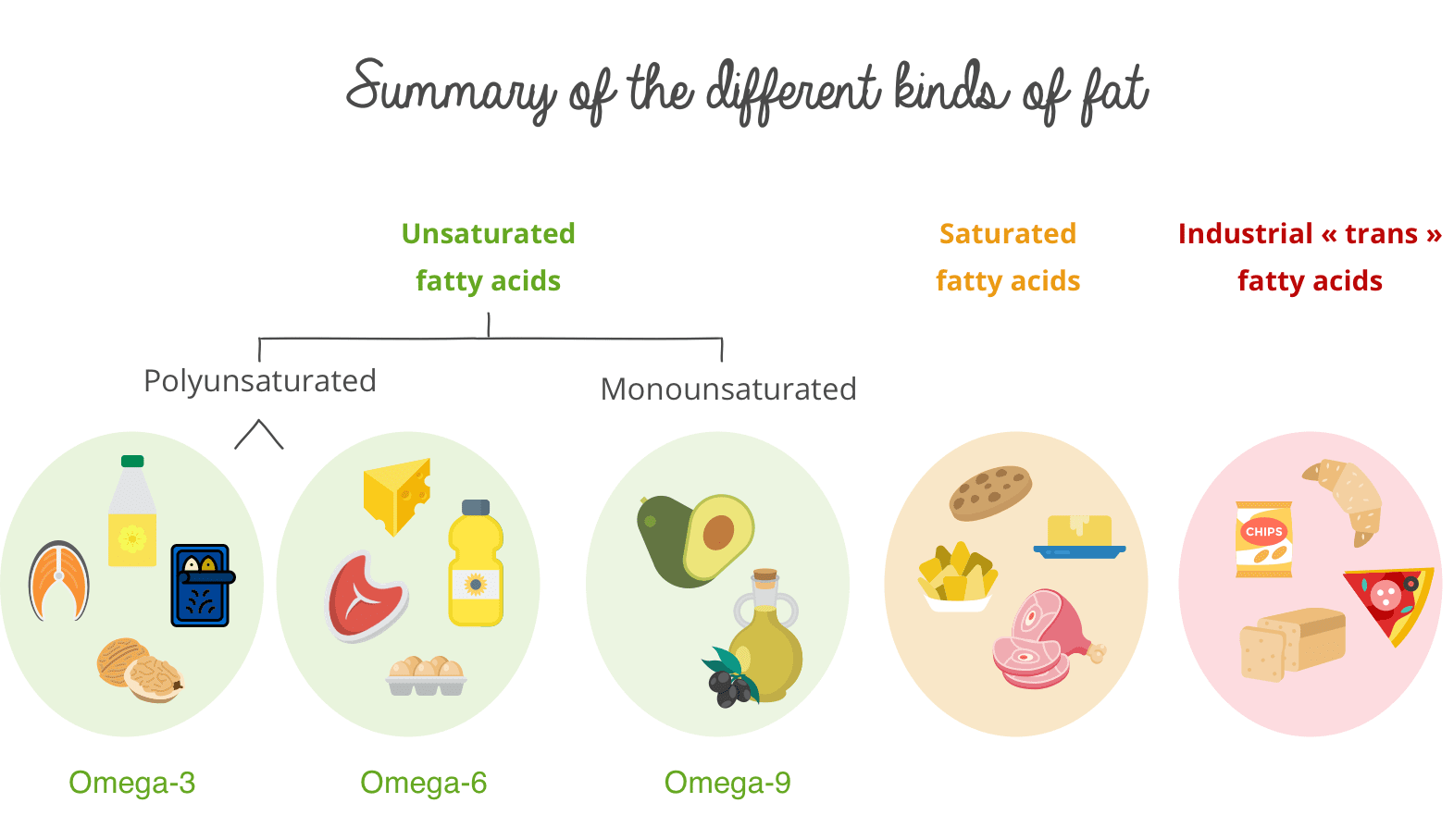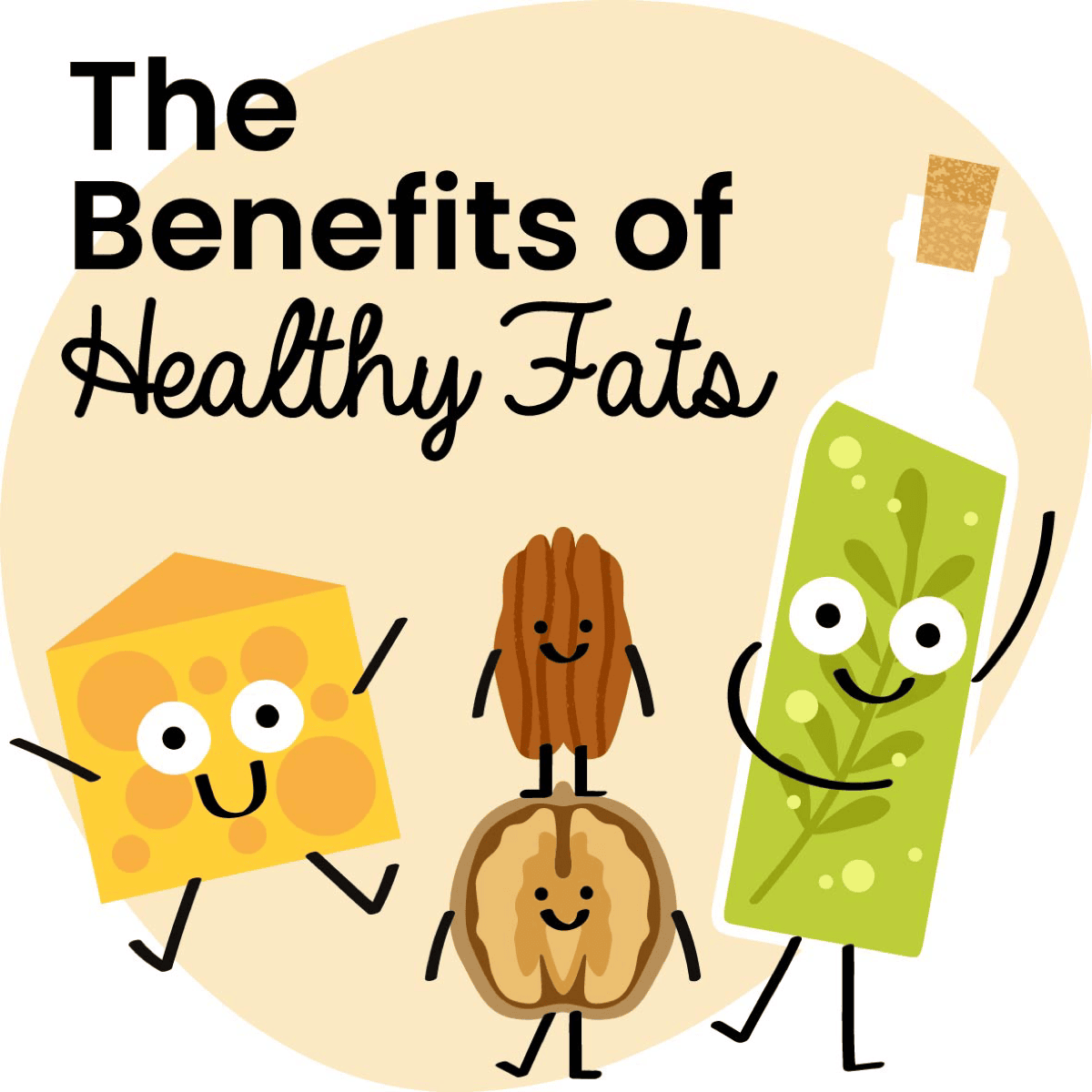Fats are sometimes referred to as lipids. There is a lot of confusion around “dietary fat” and “body fat”, which can lead to the false conclusion that dietary fat causes weight gain. In fact, fats are crucial to keeping our bodies working properly and play a limited role in weight gain when they are high quality. But not all fats are created equal: you have to know which ones are good for us.
Saturated fatty acids: limit intake
- What are they? These are fats that are solid at room temperature and stand up to heat.
- Where are they found? Saturated fatty acids are found in fats that come from:
- Animals (butter, cream, cheese, fatty meats, etc.)
- Plants (palm oil, coconut oil). They are often used in cookies, crackers and other savory snacks, such as chips.
- Are they good or bad? For a long time, saturated fatty acids were accused of increasing “bad” cholesterol and the risk of cardiovascular disease. But saturated fats are vital to our bodies: they give us energy and vitamins and help build our cellular membranes. Saturated fats in and of themselves are not the problem. However, an excess of saturated fats raises cardiovascular risk when combined with other factors, such as:
- A diet with too many carbohydrates. Consuming large amounts of saturated fats in combination with large amounts of carbohydrates (see our article on carbohydrates), as is usually the case in traditional Western diets, leads to cardiovascular disease.
- Unbalanced fat intake. These days, we eat too much saturated fat and omega-6 relative to our omega-3 intake. That imbalance contributes to cardiovascular risk.
Unsaturated fatty acids
There are three categories of unsaturated fatty acids: omega-3, omega-6 and omega-9.
Omega-3: encourage intake
- What are they? These are referred to as “essential” fatty acids because the human body cannot produce them on its own. So we must get them from our diet.
- Where are they found? Omega-3 fatty acids occur primarily in fatty fish (tuna, salmon, mackerel, sardines, etc.), certain oils (canola, linseed, walnut), seeds (chia, flax, hemp) and in some vegetables (watercress, lamb’s lettuce, cabbage).
- Are they good or bad? Omega-3 fatty acids have many beneficial properties and are critical to good health: they promote brain, muscle and bone growth. They are also a key ally in reducing cardiovascular risk and protecting our immune system. Unfortunately, on average, we only consume about 30% of our recommended daily allowance in omega-3 fatty acids.
Omega-6: limit intake
- What are they? Like omega-3 fatty acids, omega-6 fatty acids are deemed “essential” because we cannot synthesize them from the other fats we eat.
- Where are they found? The richest foods in omega-6 are red meat, eggs, butter, cheese, nuts and certain oils (sunflower, hemp, grape seed, soybean, corn, cottonseed). They are also found in large quantities in processed foods, such as cookies, chips and ready-made meals.
- Are they good or bad? Omega-6 fatty acids are indispensable because they are involved in various functions, including reproduction, immune response and brain development. But, just like saturated fats, we currently consume more than we need, which increases the risk of cardiovascular disease. Our omega-6 intake is particularly out of balance relative to our omega-3 consumption.
The omega-3/omega-6 imbalance
We should eat no more than five times more omega-6 than omega-3 fatty acids. But we actually consume 10 to 15 times more. Excessive omega-6 consumption interferes with our ability to metabolize omega-3 because they compete with each other, which means omega-3 fatty acids cannot do their job properly. This imbalance is one of the causes of cardiovascular disease.

Omega-9: encourage intake
- What are they? These are fatty acids that we can make in our body from the saturated fats that we eat; they are also found in some foods.
- Where are they found? Omega-9 fatty acids occur in large quantities in olive oil, hazelnut oil, avocado, hazelnuts and almonds. Animal fats (meat, cheese, butter) also contain generous amounts of omega-9, but they are not the best sources because they also contain a lot of saturated fat and omega-6.
- Are they good or bad? Omega-9 fatty acids play an important role in preventing diabetes and cardiovascular disease. The good news is that we are rarely deficient in omega-9 fatty acids because they are found in many foods and our body can make them from other lipid sources.
“Trans” fatty acids: avoid intake
- What are they? The vast majority of trans-fats in our diet are obtained through hydrogenation, an industrial process involving unsaturated fats. Hydrogenation is a chemical reaction that adds hydrogen molecules to the original compound. This process modifies the molecular structure of fatty acids to make them more firm and to increase their shelf life.
- Where are they found? Trans-fatty acids are found in many processed foods that have been hydrogenated to solidify plant-based fats: ready-made meals, mass-produced pastries and cookies, pie crusts, margarine, quiches, pizzas, savory snacks, spreads, granola bars, etc. Although industrial food processing techniques have managed to reduce trans-fatty acid content, it is hard to know how much a product contains because European legislation does not require that their content be disclosed.
- Are they good or bad? Trans-fatty acids should be avoided whenever possible. They have troubling consequences on human health, even when consumed in small amounts: they significantly increase the risk of cardiovascular disease.

What you can do
Today, we do not consume too much fat, but rather the wrong kinds of fat. Here are some rules to follow to restore balance to your fat intake:
- Each day, eat two tablespoons of first cold pressed canola or walnut oil in a vinaigrette or as a flavoring for your food.
- Eat fatty fish one to two times a week, favoring small fish (sardines, mackerel, anchovies), which contain fewer heavy metals than large fish.
- Eat a handful of walnuts and almonds each day at breakfast or as a snack.
- Reduce your consumption of fatty meats to once a week at most by limiting products derived from intensive animal farming.
- Reduce your intake of dairy fats (cheese, butter, cream, etc.) and try to eat them at breakfast or lunch.
- Try to cook on low heat to protect omega-3 and omega-6 fatty acids from oxidation.
- Avoid processed foods, especially when they contain “partially hydrogenated fats”.
- Siri-Tarino, P. W., Sun, Q., Hu, F. B., & Krauss, R. M. (2010). Saturated fat, carbohydrate, and cardiovascular disease. The American journal of clinical nutrition, 91(3), 502-509.
- DiNicolantonio JJ, Lucan SC, O'Keefe JH. The Evidence for Saturated Fat and for Sugar Related to Coronary Heart Disease. Prog Cardiovasc Dis. 2016 Mar-Apr;58(5):464-72. doi: 10.1016/j.pcad.2015.11.006. Epub 2015 Nov 14. Review.
- Swanson D, Block R, Mousa SA. Omega-3 fatty acids EPA and DHA: health benefits throughout life. Adv Nutr. 2012 Jan;3(1):1-7. doi: 10.3945/an.111.000893. Epub 2012 Jan 5. Review.
- Nichols PD, McManus A, Krail K, Sinclair AJ, Miller M. Recent advances in omega-3: Health Benefits, Sources, Products and Bioavailability. Nutrients. 2014;6(9):3727–3733. Published 2014 Sep 16.
- Patterson E, Wall R, Fitzgerald GF, Ross RP, Stanton C. Health implications of high dietary omega-6 polyunsaturated Fatty acids. J Nutr Metab. 2012;2012:539426. doi: 10.1155/2012/539426. Epub 2012 Apr 5.
- Innes JK, Calder PC. Omega-6 fatty acids and inflammation. Prostaglandins Leukot Essent Fatty Acids. 2018 May;132:41-48. doi: 10.1016/j.plefa.2018.03.004. Epub 2018 Mar 22. Review.
- Étude individuelle nationale des consommations alimentaires 3 (INCA 3) - Avis de l’Anses - Rapport d’expertise collective.
- Simopoulos AP. The importance of the ratio of omega-6/omega-3 essential fatty acids. Biomed Pharmacother. 2002 Oct;56(8):365-79. Review.
- Simopoulos AP. An Increase in the Omega-6/Omega-3 Fatty Acid Ratio Increases the Risk for Obesity. Nutrients. 2016;8(3):128. Published 2016 Mar 2.
- DiNicolantonio JJ, O'Keefe JH. Importance of maintaining a low omega-6/omega-3 ratio for reducing inflammation. Open Heart. 2018;5(2):e000946. Published 2018 Nov 26. doi:10.1136/openhrt-2018-000946
- de Lorgeril M, Salen P. New insights into the health effects of dietary saturated and omega-6 and omega-3 polyunsaturated fatty acids. BMC Med. 2012;10:50. Published 2012 May 21.
- Bernard, Carole & Vanduffel, Steven & Ye, Jiang, 2019. "Optimal strategies under Omega ratio," European Journal of Operational Research, Elsevier, vol. 275(2), pages 755-767.
- Delgado GE, Krämer BK, Lorkowski S, März W, von Schacky C, Kleber ME. Individual omega-9 monounsaturated fatty acids and mortality-The Ludwigshafen Risk and Cardiovascular Health Study. J Clin Lipidol. 2017 Jan - Feb;11(1):126-135.e5. doi: 10.1016/j.jacl.2016.10.015. Epub 2016 Nov 10.
- Dhaka V, Gulia N, Ahlawat KS, Khatkar BS. Trans fats-sources, health risks and alternative approach - A review. J Food Sci Technol. 2011;48(5):534–541.
- Iqbal MP. Trans fatty acids - A risk factor for cardiovascular disease. Pak J Med Sci. 2014;30(1):194–197. doi:10.12669/pjms.301.4525
- Mozaffarian D, Aro A, Willett WC. Health effects of trans-fatty acids: experimental and observational evidence. Eur J Clin Nutr. 2009 May;63 Suppl 2:S5-21. doi: 10.1038/sj.ejcn.1602973. Review.
- Shah B, Thadani U. Trans fatty acids linked to myocardial infarction and stroke: What is the evidence? Trends Cardiovasc Med. 2019 Jul;29(5):306-310. doi: 10.1016/j.tcm.2018.09.011. Epub 2018 Sep 19. Review.





